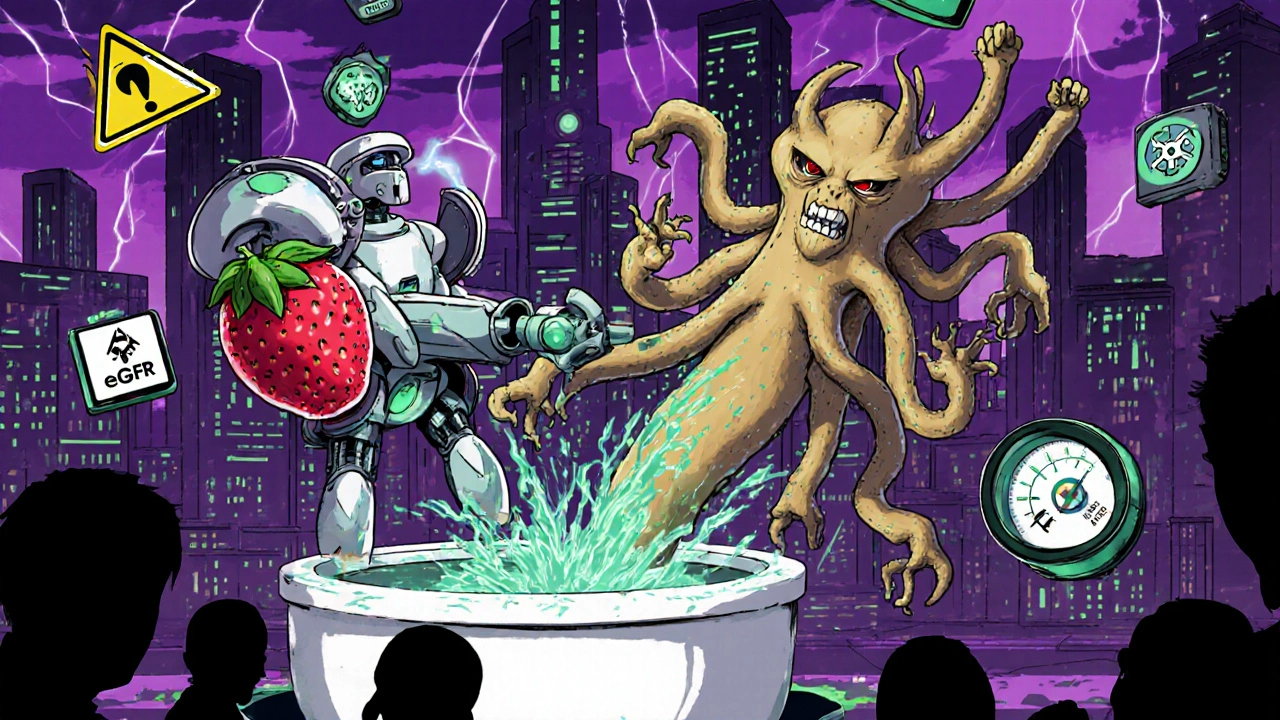When you’re managing type 2 diabetes, finding a medication that lowers blood sugar without causing low blood sugar or weight gain feels like a win. That’s why SGLT2 inhibitors like canagliflozin, dapagliflozin, and empagliflozin became so popular. But there’s a hidden catch: these drugs increase your risk of yeast infections and serious urinary problems - and many people don’t realize it until it’s too late.
How SGLT2 Inhibitors Work (and Why They Cause Infections)
SGLT2 inhibitors work by telling your kidneys to dump excess sugar into your urine. Normally, your kidneys reabsorb glucose back into your bloodstream. These drugs block that process, so glucose leaves your body through pee. That’s how they lower blood sugar - no insulin needed.
But here’s the problem: sugar in urine is food for yeast and bacteria. Fungi like Candida thrive in that sweet, warm environment. The result? Genital yeast infections. In clinical trials, 3-5% of people taking SGLT2 inhibitors developed these infections, compared to just 1-2% on placebo. For women, it’s usually vulvovaginal candidiasis - itching, burning, thick white discharge. For men, it’s balanitis: redness, swelling, pain around the head of the penis.
These aren’t just annoying. They often show up within the first few months of starting the drug. And if you’re already prone to yeast, your risk jumps even higher.
When Yeast Turns Dangerous: Urinary Tract Infections and Beyond
Genital yeast infections are one thing. But when bacteria hitch a ride on that sugary urine stream, things get serious.
Studies show SGLT2 inhibitors raise your risk of urinary tract infections (UTIs) by nearly 80% compared to other diabetes drugs like DPP-4 inhibitors. That’s not a small bump - it’s a clear signal your body is now a breeding ground for infection.
Most UTIs are mild: burning when you pee, needing to go often. But with SGLT2 inhibitors, these can turn into complicated infections fast. The FDA reviewed data from 2013 to 2014 and found 19 cases of urosepsis - a life-threatening bloodstream infection that started in the urinary tract. Ten of those cases involved canagliflozin. Nine involved dapagliflozin. Four patients needed intensive care. Two needed dialysis.
One case reported in the National Institutes of Health involved a 64-year-old woman who developed emphysematous pyelonephritis - a rare, gas-forming kidney infection that destroyed tissue. She needed surgery, 14 days of IV antibiotics, and later had a recurrence after restarting the drug. She told her doctor: “I never had urinary problems before this medication.”
Who’s Most at Risk?
Not everyone on SGLT2 inhibitors gets infections. But certain people are far more vulnerable:
- Women - due to shorter urethras and proximity of genital area to anus
- People with a history of recurrent UTIs or yeast infections
- Those with poor genital hygiene or who don’t drink enough water
- People over 65
- Those with kidney problems (eGFR below 60)
- Patients with HbA1c above 8.5% - more sugar in urine means more fuel for microbes
A 2024 study in Diabetes Care created a simple 5-point risk score. If you score 3 or higher, your chance of a serious UTI jumps to over 15%. That’s not something to ignore.

What the Experts Say
The FDA added black box warnings to SGLT2 inhibitor labels in 2015 after seeing those 19 urosepsis cases. Their warning? “Tenderness, redness, or swelling in the genital area - especially with fever or feeling unwell - requires immediate medical attention.”
The European Medicines Agency added a warning for Fournier’s gangrene - a rare but deadly necrotizing infection of the genitals and perineum. It’s rare - less than 1 in 10,000 - but it kills fast. One patient in a case report died within 48 hours of symptom onset.
Dr. Jane Jeffrie at Johns Hopkins says: “Patients need to know this isn’t just ‘a yeast infection.’ If you feel off, don’t wait. Go to urgent care.”
How to Reduce Your Risk
If you’re on an SGLT2 inhibitor and want to avoid infection, here’s what works:
- Drink more water. Diluting urine flushes out sugar and bacteria. Aim for at least 2 liters a day.
- Practice good hygiene. Wash daily with mild soap. Dry thoroughly - especially in skin folds. Don’t use scented wipes or douches.
- Urinate after sex. This helps flush out bacteria that may have entered the urethra.
- Don’t ignore symptoms. Burning, itching, unusual discharge, fever, flank pain - these aren’t normal. Don’t wait for your next appointment.
- Consider cranberry. A 2023 FDA safety update noted that cranberry products may reduce UTI risk by nearly 30% in SGLT2 users. It’s not a cure, but it’s a low-risk backup.
Some patients switch to DPP-4 inhibitors or GLP-1 receptor agonists like semaglutide. These drugs lower blood sugar without dumping glucose into urine - so they don’t cause yeast infections. They’re just as good for the heart and kidneys, and they don’t carry the same infection risk.
When to Stop or Switch Medications
Not everyone needs to quit SGLT2 inhibitors. If you’ve been on one for two years with no issues, you’re likely fine. But if you’ve had two or more yeast infections or one UTI that required antibiotics, talk to your doctor.
Doctors now use a simple rule: If you have a history of recurrent UTIs, structural bladder problems, or are immunocompromised - skip SGLT2 inhibitors. Start with metformin, then move to a GLP-1 agonist. You’ll still get the heart and kidney benefits without the infection risk.
Real-world data from Sweden shows 23.7% of people on SGLT2 inhibitors stopped taking them within two years - mostly because of side effects. That’s more than double the rate for DPP-4 inhibitors.

The Bigger Picture: Benefits vs. Risks
Let’s be clear: SGLT2 inhibitors save lives. In the EMPA-REG trial, empagliflozin cut heart attack, stroke, and heart failure deaths by 14%. In the CANVAS trial, canagliflozin did the same. They also slow kidney disease progression - a huge win for diabetics.
But those benefits are strongest in people with existing heart or kidney disease. If you’re young, healthy, and just need to lower your A1c, there are safer options.
The American Diabetes Association says: Use SGLT2 inhibitors for patients with heart failure or chronic kidney disease. For others, especially those with a history of infections, choose something else.
What to Do Next
If you’re on an SGLT2 inhibitor:
- Check your genitals weekly for redness, swelling, or unusual discharge.
- Track how often you get UTIs. If it’s more than once a year, that’s a red flag.
- Ask your doctor: “Based on my history, is this still the best drug for me?”
- Don’t be afraid to ask for alternatives. There are other powerful drugs that won’t turn your urinary tract into a yeast farm.
If you’re not on one yet but have recurrent infections, don’t let your doctor push you into this class. Say: “I’ve had three yeast infections in the last year. Is there another option?”
Diabetes treatment isn’t one-size-fits-all. The best drug is the one that keeps your blood sugar down - without putting your health at risk.
Can SGLT2 inhibitors cause yeast infections in men?
Yes. While vulvovaginal yeast infections are more common in women, men taking SGLT2 inhibitors can develop balanitis - inflammation of the head of the penis. Symptoms include redness, itching, swelling, and sometimes a thick white discharge. It’s caused by the same yeast, Candida, thriving in sugary urine. Good hygiene and staying hydrated can help prevent it.
How soon after starting SGLT2 inhibitors do infections usually appear?
Most genital infections show up within the first 3 months. UTIs can appear anytime, but the highest risk is in the first 6 months. The FDA found that the median time to serious infection like urosepsis was 45 days after starting the drug. That’s why early monitoring is critical.
Are there any natural ways to prevent UTIs while on SGLT2 inhibitors?
Yes. Drinking plenty of water is the most effective. Cranberry juice or supplements may reduce UTI risk by up to 29%, according to a 2023 FDA safety update. Probiotics containing Lactobacillus strains may help restore healthy vaginal flora, especially in women. But these are supportive - not replacements for medical care if symptoms appear.
Can I still take SGLT2 inhibitors if I’ve had a yeast infection before?
It depends. If you’ve had one mild infection and it cleared up quickly, you may be fine with extra care. But if you’ve had two or more, or if they keep coming back, your doctor should consider switching you to a different class of diabetes medication. The risk of recurrence is high - and each infection increases your chance of something more serious.
What are the signs of a serious urinary infection from SGLT2 inhibitors?
Don’t ignore these: fever above 100.4°F, flank pain (side or back pain), nausea or vomiting, confusion, or swelling/tenderness from your genitals to your rectum. These could mean you have pyelonephritis, urosepsis, or even Fournier’s gangrene - all medical emergencies. Go to urgent care or the ER immediately. Delaying treatment can lead to kidney failure or death.
Do SGLT2 inhibitors affect kidney function?
They usually protect kidney function over time, especially in people with diabetic kidney disease. But during an active infection, your kidneys can be stressed. If you develop a UTI or pyelonephritis, your eGFR may drop temporarily. That’s why treating infections fast is so important - to prevent lasting kidney damage.
Final Thoughts
SGLT2 inhibitors are powerful tools - but they’re not for everyone. Their benefits for the heart and kidneys are real. But so are the risks. If you’re getting frequent yeast infections or UTIs, it’s not just bad luck. It’s a signal from your body that this drug isn’t right for you.
There are other options that work just as well for your heart and kidneys - without turning your urine into a yeast buffet. Talk to your doctor. Ask questions. Don’t let fear of changing meds keep you stuck with something that’s making you sick.


Mary Follero
November 20, 2025 AT 04:08I was on dapagliflozin for six months and had three yeast infections in a row. No joke, I thought I was going crazy until I read this. My OB literally said, ‘You’re peeing sugar-that’s a buffet for Candida.’ I switched to metformin and haven’t had one since. If you’re getting recurrent infections, don’t wait-talk to your doctor. This isn’t normal.
Also, cranberry pills? Game changer. Not a cure, but they definitely cut down the frequency. Just don’t drink the juice-it’s got so much sugar it defeats the purpose.
Will Phillips
November 20, 2025 AT 18:58Big Pharma doesn't want you to know this but SGLT2 inhibitors were designed to make people sick so they'd buy more drugs. You think it's coincidence that the same companies selling these pills also sell antifungals and antibiotics? Think about it. They profit off your suffering. The FDA? Bought and paid for. I know a guy who got Fournier's gangrene after one dose. They buried it. I've got the medical records. They don't want you to see this post. That's why it's still up.
Stop trusting doctors. Start reading the labels. Your body is not a lab rat.
Arun Mohan
November 22, 2025 AT 18:32Oh please. You're all acting like this is some groundbreaking revelation. SGLT2 inhibitors have been studied since the early 2000s. The mechanism is textbook: glucosuria → fungal overgrowth → infection. It's basic microbiology. The fact that people are shocked means they never bothered to read the prescribing info before accepting a script from their GP who's paid by pharma reps.
Also, cranberry? Please. That’s like putting a bandaid on a ruptured aneurysm. If you’re diabetic and prone to UTIs, the only rational choice is GLP-1 agonists. DPP-4 inhibitors are mediocre at best. And yes, I’ve published papers on this. You’re welcome.
Tyrone Luton
November 23, 2025 AT 13:05It’s funny how we’ve turned medicine into a spreadsheet. We optimize for A1c numbers while ignoring the body’s screams. Sugar in urine isn’t just a side effect-it’s a betrayal of biological design. Our kidneys weren’t meant to excrete glucose. We’re forcing them to, and then acting surprised when the system breaks down.
Maybe the real question isn’t ‘how to prevent yeast infections’ but ‘why are we prescribing drugs that turn our bodies into petri dishes?’ We’ve forgotten that health isn’t a metric-it’s a harmony.
And yes, I’ve been on one for three years. No infections. But I drink 3 liters of water a day. And I pray. Not because I’m religious. Because I’m terrified.
darnell hunter
November 24, 2025 AT 12:01According to the FDA Adverse Event Reporting System (FAERS), between 2013 and 2023, there were 1,472 documented cases of urosepsis associated with SGLT2 inhibitors. Of these, 38% resulted in hospitalization, and 12% resulted in mortality. The relative risk increase for genital mycotic infections was 2.8-fold (95% CI: 2.4–3.3). This is not anecdotal. It is statistically significant, clinically relevant, and ethically indefensible when safer alternatives exist.
Patients with a history of recurrent urinary tract infections should be contraindicated for this class. Period.
Hannah Machiorlete
November 25, 2025 AT 14:04I hate how everyone acts like this is some new thing. I got yeast infections every time I took these meds. Like, every. single. time. I told my doctor and she just handed me another prescription for fluconazole like it was candy. Then I started reading the fine print and realized I was basically feeding a fungus. I quit cold turkey and switched to metformin. No more itching. No more embarrassment. No more feeling like my body is a broken toilet.
Also why is everyone talking about cranberry like it's magic? It's just sour juice. I'd rather eat a lemon.
Bette Rivas
November 26, 2025 AT 05:27Let’s break this down clinically. The incidence of genital mycotic infections with SGLT2 inhibitors is dose-dependent and peaks within the first 90 days of initiation. The 2024 Diabetes Care risk score you referenced-valid tool, but underutilized in primary care. Most clinicians still default to prescribing these drugs for all T2D patients without assessing baseline infection history.
Hydration is critical, yes, but so is glycemic control. Higher baseline HbA1c correlates with higher urinary glucose excretion, which directly increases infection risk. A patient with HbA1c 9.8% on empagliflozin is at significantly higher risk than one with HbA1c 7.2%.
Probiotics? Lactobacillus rhamnosus GR-1 and L. reuteri RC-14 have shown in RCTs to reduce recurrence rates by 40% in women. Not a replacement for medical treatment, but a useful adjunct. And yes, cranberry proanthocyanidins inhibit bacterial adhesion-but only if standardized to 36mg PACs per dose. Most commercial products don’t even contain that.
Bottom line: individualize therapy. Don’t just prescribe the latest blockbuster. Assess risk. Monitor. Educate. That’s what medicine should look like.
prasad gali
November 27, 2025 AT 01:11From a pharmacoeconomic standpoint, SGLT2 inhibitors are cost-effective for patients with established CVD or CKD due to reduced hospitalizations for heart failure and progression to ESRD. However, the incremental cost per infection treated-antifungals, antibiotics, ER visits, hospital stays-offsets up to 28% of the long-term benefit in low-risk populations. In high-risk cohorts (recurrent UTI history, female, >65), the risk-benefit ratio flips. Guidelines are lagging real-world data. Real-world data says: avoid in high-risk patients. Period.
Also, the 23.7% discontinuation rate in Sweden? That’s not ‘side effects.’ That’s patients exercising autonomy. The system needs to respect that.
Paige Basford
November 27, 2025 AT 08:29Okay but real talk-how do you even know if it’s a yeast infection or just irritation? I had this weird itch and thought it was from my new underwear, then I Googled it and nearly had a panic attack. I went to urgent care and they were like, ‘Yep, candida.’ I was so embarrassed. I didn’t even know men could get it too. My boyfriend started taking the same med and got it too. We both had to stop. Honestly, I wish someone had warned me before I started it. It’s not just a ‘little itch.’ It’s like your whole body is screaming.
Also, I started drinking water like it was my job and it helped so much. I even got one of those fancy water bottles with the time markers. I’m basically a hydration guru now. 🤓
Ankita Sinha
November 27, 2025 AT 11:43Just started empagliflozin last month. No issues yet. But I’m already washing after every bathroom trip, drinking water like a maniac, and avoiding tight clothes. I read this post and thought-better safe than sorry. My grandma had a UTI that turned into sepsis. I don’t want to be her. I’m also tracking my symptoms in a little notebook. If I get even a tiny bit of itching, I’m calling my doctor. No waiting. No ‘maybe it’ll go away.’
Also, I asked my doc about GLP-1s. She said they’re pricier but worth it if I’m high-risk. I’m thinking about switching. This isn’t worth the stress. I’ve got enough to worry about already.